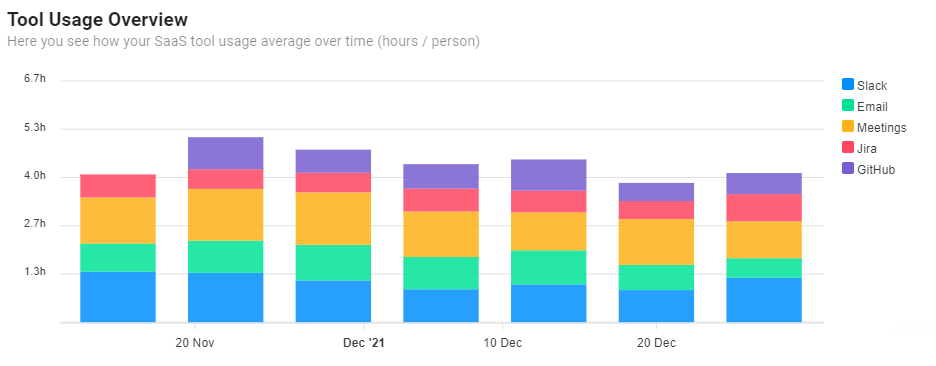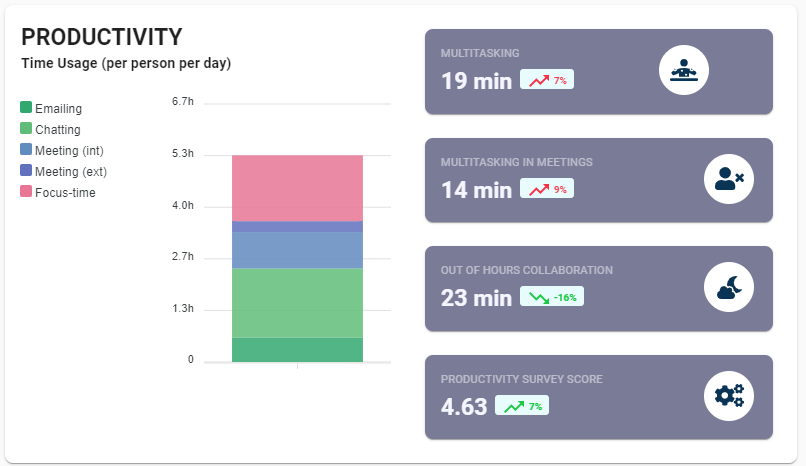Workplace Culture with the SPACE Framework: A Guide for Leadership
By using the SPACE framework, organizations can gain a 360-view into workplace culture of productivity, discover weaknesses, and prioritize...
What is the SPACE Framework? SPACE helps your teams achieve higher level of productivity by analyzing the processes and functions throughout your company.
The SPACE framework is a model for understanding and measuring productivity across different teams and organization-wide. It was developed by Nicole Forsgren, a member of the DORA team and a co-author of the book Accelerate. The goal of the framework is to delve deeper into the aspects of productivity to identify areas of improvement, understand working patterns, and evaluate the effectiveness of core business functions.
The SPACE framework is an essential model for measuring productivity for different teams as it focuses on the true aspects of productivity metrics related to the framework. The model does not factor in myths and false information that can be misleading and cause false actions to be taken regarding productivity.

To understand the SPACE framework, we need to look at the acronym in more detail.
This focuses on whether team members are happy with their work environment and whether they feel like they are able to do their best work. If team members are not satisfied, it can be directly related to productivity output. If team members feel undervalued, are continuously dissatisfied, and de-motivated, productivity levels will drop and burnout can occur. Without using the SPACE framework to assess this, it could go unnoticed.
Assessing performance allows managers to understand how efficient a team is by looking at outcomes, results, and workflows. Performance looks at the outcomes of work, and whilst being difficult to measure directly it looks more at the outcome of work rather than specific outputs or inputs. For example, this could be done by looking at team OKRs such as improving the lead flow and sales cycle time. This impacts the team as a whole, looks at the workflow, and also demonstrates results.
Activity, much like performance, should not be assessed as a single aspect of productivity. It looks at various actions or tasks that are completed in a cycle of work time. This could include actions such as phone calls handled, the amount of code reviewed, on-call participation, or the number of documents written. Managers and leaders should use this information with other metrics to understand patterns and output with a more holistic view.
Communication and collaboration are essential to team productivity across all areas of an organization. For example, when it comes to product development, it is vital that team members are able to communicate and collaborate effectively to avoid errors, misunderstandings, and duplication of work. Good communication can also improve the speed of work output as team members are able to ask for help and clarification when needed.
Efficiency and flow look at how effectively work is being completed and if any interruptions are occurring that can distract from the completion of tasks. Each factor looks at different areas, where efficiency focuses on a team level and flow focuses on individual team members. For managers, efficiency and flow can be used to reduce frustrations and bottlenecks that are occurring throughout different channels.
Commonly, productivity and performance are measured on an individual level by looking at individual processes and outputs - this is incorrect and is called 'superbias'. The SPACE Framework actually allows managers to create an overview of activity and productivity as a team.
This is essential for understanding how teams are performing and whether business goals are being met, but also which areas of the business have communication issues, lack the tools, or are interrupted regularly. It allows for a deeper look into the meanings behind why productivity is suffering and allows leaders to take action in resolving these areas of concern either before they reflect on performance or after.
“94% of most problems and possibilities for improvement belong to the system, not the individual.”
To fully understand productivity, it is vital not to consider singular outputs but rather outcomes as a result of a streamlined and engaged team. By looking at productivity factors in multiple aspects, individual team members can understand how different areas influence their productivity output, which in turn, reflects the team's productivity levels.

Implementing the SPACE Framework for your teams can be challenging to get right. Fortunately, Flowtrace focuses on multiple aspects of the SPACE Framework to give managers and teams an in-depth look at productivity factors and give them the data to make informed decisions and improve. Let's have a look at how Flowtrace integrates directly with the SPACE Framework:
Understanding employee satisfaction and well-being are vital to keeping a productive and engaged team. With Flowtrace, you can get real-time insights into how your team feels by looking at data such as multitasking, out of hours work, time spent on tasks, and even conducting eNPS surveys and team effectiveness surveys.
This data allows leaders to understand if team members have a high workload, are lacking in deep focus time, or do not have the support of other team members. For example, if the data showed that multitasking was eating a lot of the team's work time, there could be issues with tools being used, distractions, workload distribution, and many other factors.
By using this data, managers can delve deeper into the processes of that team to understand where bottlenecks may be occurring and if any improvements can be made, whilst having the data available in real-time. In addition to this, Flowtrace sends regular surveys across 8 effectiveness categories, to gain valuable insights from team members on various aspects of their work and well-being.
By assessing every aspect of the SPACE Framework in conjunction with Flowtraces features, managers can get a holistic overview of the team's performance. Performance on a team level can be correlated with the company's OKRs. Each objective set for teams will directly impact the performance they give and the working culture of the company.
These goals of performance should be considered collectively but also related to individual parts of the SPACE Framework too. They can be tracked through data from Flowtrace and can include for example:
Whilst it is not directly visible that these OKRs will have an impact on performance and productivity, they give employees and teams a structure of what the company should be achieving and helps to narrow their work focus down on achieving these results.

Activity, as mentioned previously, can be a difficult one to measure. It must be taken into consideration with other factors and metrics. Flowtrace can help with this in various ways. For example, it integrates seamlessly with GitHub to pull analytics and give managers a holistic overview of tasks completion times in different areas - product development cycle times, sales deal stage flow analytics, pull requests, and cycle times can be used to assess activity - a prominent feature of GitHub and allows a view of multiple teams. This allows managers to assess how a team is performing, trends occurring, and the time it takes to complete tasks.
Flowtrace also provides real-time data for activity across other teams by looking at:
With employees being able to see these metrics, it empowers them to shift focus and improve their activity, whereas managers can use this information to assess any distractions, bottlenecks, and workflow issues that may be impacting activity levels.
For example, if the customer service team consistently has a high meeting time correlated with a low number of calls handled, this could be a direct impact on activity levels and require a revision as to whether they need to attend meetings as often.
By using this in conjunction with the SPACE Framework and applying it with other metrics, managers can identify potential problems occurring with team activity and any impact on organizational functions.
As a collaboration diagnostics tool, this is where Flowtrace really embraces the SPACE Framework and offers a multitude of metrics to improve, assess, and fix issues. Using Flowtrace, you can analyze how your teams are interacting which can be used to identify potential information silos, communication barriers and opportunities for improvements for example, by using shared documents with direct links and using threaded chats to collate information easily.
Managers and teams will be able to visually monitor collaboration statistics that are broken down by day and even by the hour, to give a comprehensive overview of how communication patterns are occurring.
With Flowtrace, this can be reflected across all teams to identify where communication bottlenecks occur, improve inter-team and cross-functional relationships, and break down organization silos. It is important to consider different teams and responsibilities here too. For example, sales and marketing teams would have completely different data and it would not be the same across the board.
Sales teams would have a high number of calls, less time messaging, and fewer meetings due to being out of office - whereas marketing teams would be the opposite. Each team should be treated as an entirely different entity when breaking communication and collaboration down by team.

Flowtrace offers insights and daily breakdowns of deep work time, meeting times, time spent on chat/communication channels, and emails - this is ideal for managers to understand how efficient teams are being with their time. For example, if teams only had 60 minutes of deep work/focus time available, productivity could be suffering. This is where changes can be implemented and reviewed in conjunction with other aspects of SPACE.
For example, with Flowtrace pulling analytics from the likes of Jira and Github, there is also data present to see how process flow is progressing or being delayed, and how much focus time is being applied to the right place. Leaders can use this information to adjust practices based on internal goals and on team productivity requirements.
Managers can use data such as multitasking, projects collaborated on, tools used, and more to identify any workflow issues. If a project has to cycle through 7 different teams to reach a conclusion, there be areas to fix the workflow cycle and reduce this to 4 - increasing the efficiency for teams and having an effect on other productivity factors across teams.
There are many different metrics that be looked at here including speed of IT systems, distractions, handoffs, and code review processes. Each one will allow leaders to identify bottlenecks and areas that require improvements to increase team productivity.
As mentioned consistently throughout this article, managers should never rely solely on individual metrics of the SPACE Framework. For example, a slow code review process could be related to efficiency and flow in the Framework, but could be due to communication channel issues. That is why the framework should be used collectively to create a holistic overview of team productivity levels.
Try to identify patterns and trends in the data rather than using the data in its raw state. For example, if you saw that communication had dropped for a day it would be unwise to act on this alone. Whereas if communication levels dropped at the same time every week but also coincided with drops in efficiency and output, there could be an underlying issue.
The SPACE Framework is a great way for managers to identify and assess areas for improvement in team productivity. By using Flowtrace together with the SPACE Framework, leaders can gain deep insights into how teams are working and collaborating which can help them make changes that will improve overall efficiency. While there are many different metrics that can be looked at, it's important not to rely on individual data points and instead try to find patterns and trends. When used correctly, the SPACE Framework can be an invaluable tool for boosting organizational productivity.
By using the SPACE framework, organizations can gain a 360-view into workplace culture of productivity, discover weaknesses, and prioritize...
Understand how to measure development productivity using Flowtrace and SPACE framework. We give you the vital information to improve team...
Understanding how to reduce interruptions at the workplace can have a positive impact on your teams output and the overall productivity of the...